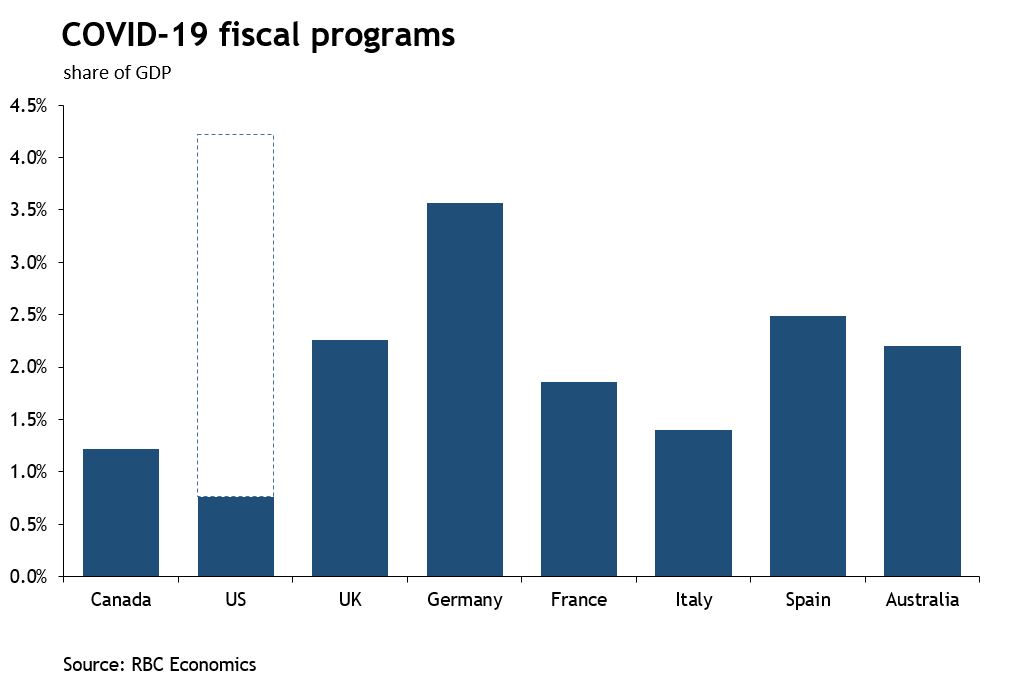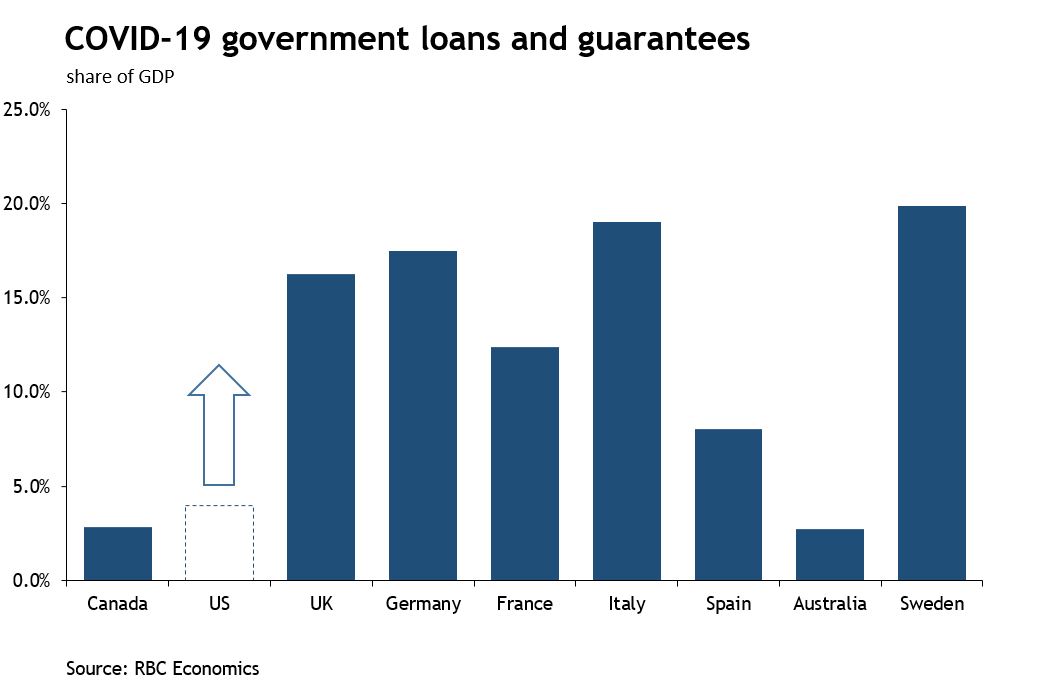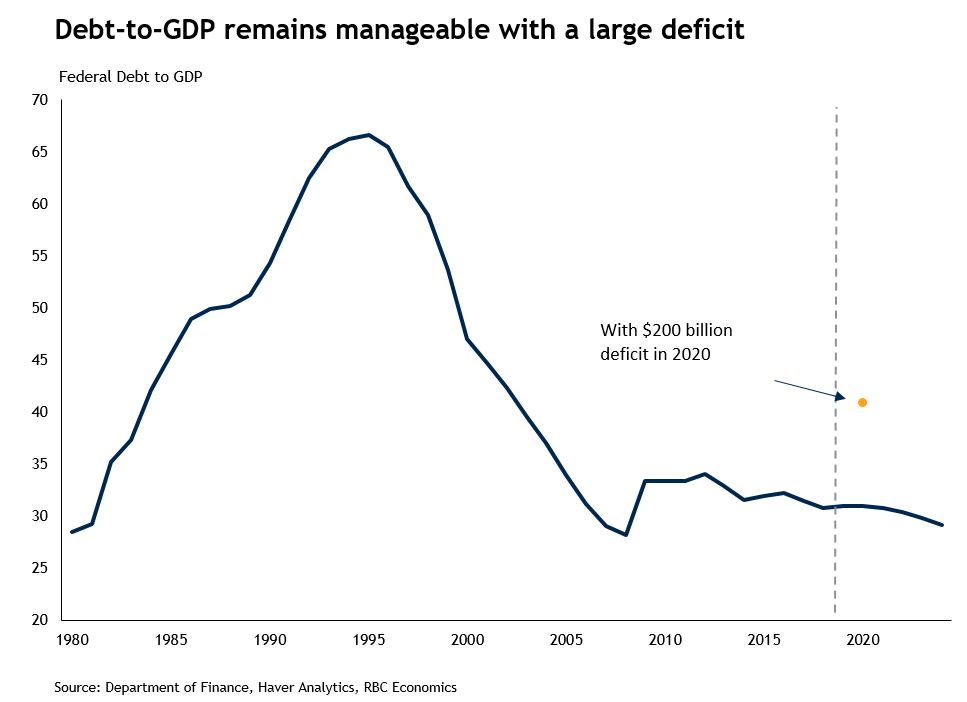Canada's phase one of the COVID-19 fiscal stimulus was launched only a week ago and already it appears that it isn't enough.
The demands are rising as quickly as the pandemic is spreading around the globe and across the country. Globally countries have been aggressively ratcheting up public sector support for their respective economies leaving Canada’s phase one package looking relatively light. We expect more aggressive announcements to come over the weeks ahead. Any further initiatives will have to remain scalable so they can ramp up if needed and be pulled back once the economy normalizes. The extensive stimulus will push the federal deficit up significantly but it will remain manageable over the near-term. In the long run, the debt-to-GDP ratio will improve as long as GDP growth is higher than interest rates. Once the economy starts to grow, the low rate environment will put the ratio on an improving trend.
Monetary policy will play a complimentary role to fiscal policy in this environment. To-date the attention in Canada has been moving interest rates significantly lower and ensuring the financial system’s plumbing remains functioning. The goal has been to keep the system flush with liquidity and keep credit channels from clogging up. Moving forward we expect the Bank of Canada to ratchet up its actions, moving interest rates effectively to zero and likely heading down a path not yet traveled, quantitative easing.
Canada lagging global peers
Global peers have announced sizeable fiscal packages almost on a daily basis. Some have been put their fiscal plans in place while others, like the U.S., are still at the drawing board. What they all have in common is that as a share of GDP these packages all come in much larger than Canada’s phase one stimulus. In terms of direct spending Canada’s phase one package totaled 1.2% of GDP, not including the temporary deferral of tax payments which will add another 2.4%.


Feds have room for more aggressive actions
When we look at the potential fiscal capacity for the federal government we find there is plenty of room for more aggressive action. For the current fiscal year, FY2020/21 the fall estimate was for a deficit of $28.1 billion. Obviously this projection was based on an entirely different set of economic circumstances. We currently expect a recession in the first half of the year with an annual GDP decline of 2.5%. Adjusting this current year for the significantly weaker economy and the fiscal packages announced to date, the starting deficit is likely closer to $86 billion. Reflecting the larger deficit and weaker economy, the debt-to-GDP ratio is likely closer to 35% than the fall estimate of 31%.
Deficit of $200 billion if government matches global peers
Even after these adjustments, the ratio remain well below the average debt burden across the industrial world. Economic theory provides little in terms of how much debt is too much but there is plenty of room for the federal government to run higher deficits and debt. As the charts on page 1 show, Canada’s fiscal response to date has been relatively modest compared to others despite our favourable debt-to-GDP ratio. If the federal government were to match the average stimulus seen across the other countries, the deficit would rise to around $200 billion, representing 10% of GDP. While a large number on its own, the debt-to-GDP ratio would rise to about 41%. This would still compare quite favourably to our global peers and remain moderate even relative to our fiscal past. Assuming a deficit of this magnitude is introduced, it will be manageable assuming the package is scalable and is successful in stemming the economic decline that is upon us.

This article is intended as general information only and is not to be relied upon as constituting legal, financial or other professional advice. A professional advisor should be consulted regarding your specific situation. Information presented is believed to be factual and up-to-date but we do not guarantee its accuracy and it should not be regarded as a complete analysis of the subjects discussed. All expressions of opinion reflect the judgment of the authors as of the date of publication and are subject to change. No endorsement of any third parties or their advice, opinions, information, products or services is expressly given or implied by Royal Bank of Canada or any of its affiliates.


 Learn More
Learn More